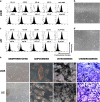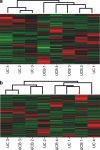Gene expression profile of mesenchymal stem cells from paired umbilical cord units: cord is different from blood
- PMID: 20058202
- PMCID: PMC2803263
- DOI: 10.1007/s12015-009-9098-5
Gene expression profile of mesenchymal stem cells from paired umbilical cord units: cord is different from blood
Abstract
Mesenchymal stem cells (MSC) are multipotent cells which can be obtained from several adult and fetal tissues including human umbilical cord units. We have recently shown that umbilical cord tissue (UC) is richer in MSC than umbilical cord blood (UCB) but their origin and characteristics in blood as compared to the cord remains unknown. Here we compared, for the first time, the exonic protein-coding and intronic noncoding RNA (ncRNA) expression profiles of MSC from match-paired UC and UCB samples, harvested from the same donors, processed simultaneously and under the same culture conditions. The patterns of intronic ncRNA expression in MSC from UC and UCB paired units were highly similar, indicative of their common donor origin. The respective exonic protein-coding transcript expression profiles, however, were significantly different. Hierarchical clustering based on protein-coding expression similarities grouped MSC according to their tissue location rather than original donor. Genes related to systems development, osteogenesis and immune system were expressed at higher levels in UCB, whereas genes related to cell adhesion, morphogenesis, secretion, angiogenesis and neurogenesis were more expressed in UC cells. These molecular differences verified in tissue-specific MSC gene expression may reflect functional activities influenced by distinct niches and should be considered when developing clinical protocols involving MSC from different sources. In addition, these findings reinforce our previous suggestion on the importance of banking the whole umbilical cord unit for research or future therapeutic use.
Figures



Similar articles
-
Multipotent stem cells from umbilical cord: cord is richer than blood!Stem Cells. 2008 Jan;26(1):146-50. doi: 10.1634/stemcells.2007-0381. Epub 2007 Oct 11. Stem Cells. 2008. PMID: 17932423
-
Optimization of human umbilical cord blood-derived mesenchymal stem cell isolation and culture methods in serum- and xeno-free conditions.Stem Cell Res Ther. 2022 Jan 10;13(1):15. doi: 10.1186/s13287-021-02694-y. Stem Cell Res Ther. 2022. PMID: 35012671 Free PMC article.
-
[Effect of Hypoxia-Supported Umbilical Cord Mesenchymal Stem Cells on the Expansion of Cord Blood Mononuclear Cells in vitro].Zhongguo Shi Yan Xue Ye Xue Za Zhi. 2023 Feb;31(1):227-232. doi: 10.19746/j.cnki.issn.1009-2137.2023.01.036. Zhongguo Shi Yan Xue Ye Xue Za Zhi. 2023. PMID: 36765504 Chinese.
-
Transplantation of stem cells from umbilical cord blood as therapy for type I diabetes.Cell Tissue Res. 2019 Nov;378(2):155-162. doi: 10.1007/s00441-019-03046-2. Epub 2019 Jun 17. Cell Tissue Res. 2019. PMID: 31209568 Review.
-
Mitigation of acute radiation syndrome (ARS) with human umbilical cord blood.Int J Radiat Biol. 2024;100(3):317-334. doi: 10.1080/09553002.2023.2277372. Epub 2023 Nov 15. Int J Radiat Biol. 2024. PMID: 37967239 Review.
Cited by
-
Tracking of In-111-labeled human umbilical tissue-derived cells (hUTC) in a rat model of cerebral ischemia using SPECT imaging.BMC Med Imaging. 2012 Dec 6;12:33. doi: 10.1186/1471-2342-12-33. BMC Med Imaging. 2012. PMID: 23217090 Free PMC article.
-
Defined MSC exosome with high yield and purity to improve regenerative activity.J Tissue Eng. 2021 Apr 20;12:20417314211008626. doi: 10.1177/20417314211008626. eCollection 2021 Jan-Dec. J Tissue Eng. 2021. PMID: 33959246 Free PMC article.
-
Human umbilical cord mesenchymal stem cells in type 2 diabetes mellitus: the emerging therapeutic approach.Cell Tissue Res. 2021 Sep;385(3):497-518. doi: 10.1007/s00441-021-03461-4. Epub 2021 May 29. Cell Tissue Res. 2021. PMID: 34050823 Review.
-
A dose-dependent function of follicular fluid on the proliferation and differentiation of umbilical cord mesenchymal stem cells (MSCs) of goat.Histochem Cell Biol. 2012 Oct;138(4):593-603. doi: 10.1007/s00418-012-0975-7. Epub 2012 Jun 10. Histochem Cell Biol. 2012. PMID: 22684927
-
GD2 expression is closely associated with neuronal differentiation of human umbilical cord blood-derived mesenchymal stem cells.Cell Mol Life Sci. 2010 Jun;67(11):1845-58. doi: 10.1007/s00018-010-0292-z. Epub 2010 Feb 18. Cell Mol Life Sci. 2010. PMID: 20165901 Free PMC article.
References
Publication types
MeSH terms
Substances
LinkOut - more resources
Full Text Sources
Other Literature Sources
Molecular Biology Databases

